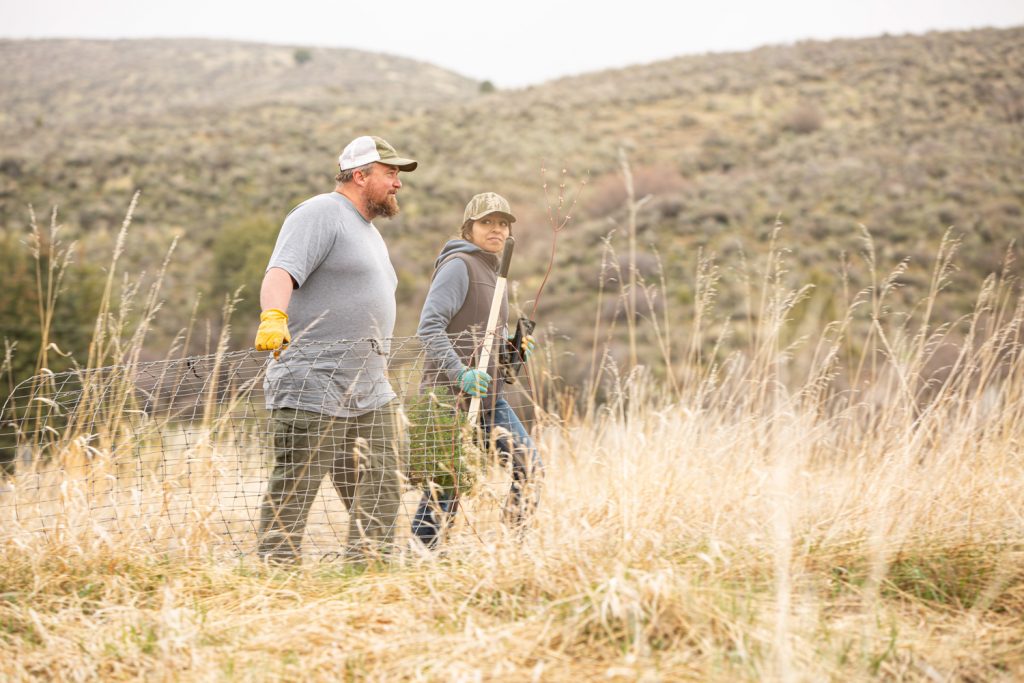Conservation Parties and Better Turkey Habitat
“We have a lot of fun with all the volunteers who show up to these events. It’s like a conservation party.”
NWTF chapters throughout the country are known for rolling up their sleeves and making as much a difference in their community as they do for wildlife habitat, and the local chapters in Idaho are no different. A partnership between the NWTF Idaho State Chapter and Idaho Fish and Game is enhancing wild turkey habitat and engaging volunteers from all spectrums of the community.
“People often wonder ‘what can I do to benefit wildlife in my area’ or ‘how can I get involved with the community,’” said Joe Foster, NWTF Idaho State Chapter president. “Our partnership with Idaho Fish and Game is the perfect example of how you can get involved with work that benefits hunters and wildlife alike.”
To increase habitat for turkeys and other critters in the region, the NWTF State Chapter and Idaho Fish and Game have partnered over the last 15 years, combining funds and engaging the community. This partnership has resulted in more than 10,000 trees and shrubs being planted throughout the southeastern part of the state, countering the dry conditions and greatly benefitting overall biodiversity.
“We have a lot of fun with all the volunteers who show up to these events,” Foster said. “It’s like a conservation party.”
Plants play an important role in wild turkey habitat. They provide crucial food, nesting, concealment and shelter for turkeys and many other critters alike, but in southeastern Idaho, the lack of rain often hinders the growth of nearly all shrubs and trees, making habitat less than ideal.
Recently, the NWTF, Idaho Fish and Game and volunteers from throughout the community completed the 1,000 Roost Tree Project, which, as the name suggests, included planting 1,000 trees on 15 different sites throughout two wildlife management areas.
To combat dry conditions in southeastern Idaho, which receives only about 12 inches of precipitation a year (most of it snow), the NWTF Idaho State Chapter funded and was awarded additional grant funding to purchase 600 Groasis Waterboxxes.
Made from bioplastics that decompose naturally, these water boxes are designed to retain water for an extended period, greatly helping trees survive in dry areas.
“This technology allows trees to survive in difficult circumstances without using groundwater or electricity,” Foster said. “The boxes are initially filled with about five gallons of water, which is distributed over an extended period to the tree growing in the center, and they collect any rainwater and condensation that may become available. It’s a dedicated ‘plant guzzler,’ if you will.”
The boxes allow for an array of other benefits, including preventing evaporation of groundwater, steadying the temperature around the roots, fighting competitive weeds near planted trees and helping prevent damage from rodents.
“The benefits from tree plantings provide long-term results, in excess of 50 years, and address management needs in the WMAs where the plantings are taking place,” said Collin Smith, NWTF district biologist for Idaho, Wyoming and Montana.
NWTF volunteers start the tree-planting process by staging young plants in a tree yard where they can be monitored more effectively while acclimating to the southeastern Idaho soil and climate conditions, before going out on WMA habitat projects. This greatly improves the success of the transplanted trees and shrubs.

“The tree yard was built eight years ago with the help of local Boy Scout troops, and it can hold up to 500 potted shrubs and trees at a time,” Foster said.
Once trees adapt to conditions, the NWTF hosts field days where the NWTF and Idaho Fish and Game engage the community to help transplant trees and shrubs in critical areas of the WMAs.
Though the long-term results of the new water boxes are not fully known yet, partners all agree that any additional water to these trees will be a welcomed bonus.
“While wild turkeys are our focus, deer, moose, upland game birds and many nongame species will benefit from improved security cover, bedding areas, nesting sites, thermal protection and mast forage sites created from these trees,” Smith said. “In the long term, mature trees will provide roost sites for wild turkeys and perches for other birds.”
Whether it’s bringing the community together for the common good, creating opportunities for sportsmen and women, forging new partnerships or using innovative technologies to benefit wildlife on a scale that makes an impact, it’s safe to say the local NWTF Idaho chapters are embodying the NWTF mission at large.
